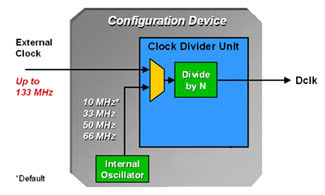
Intel FPGAs operate by storing configuration data in internal SRAM memory. However, since SRAM is volatile, the configuration data inside the FPGA is lost when the power to the FPGA is turned off.
Therefore, it is necessary to prepare a non-volatile memory as a configuration device separate from the FPGA, or read the configuration data from a download cable, etc.
feature
Intel serial configuration devices are the industry's easiest-to-use configuration devices.
Serial configuration devices not only have ISP (In-System Programmability) and reprogramming functions, but also have a longer product life than serial flash products, so the product of the system to be implemented Provides flexibility as a configuration device for lifetime.
Serial configuration devices have the following features:
|
The generated configuration data is efficiently compressed by the Quartus II software by about half or less. The compressed data is then downloaded to the configuration device, where it is decompressed by the decompression engine and sent to the programmable logic device (PLD), as shown in Figure 1. |
|
Figure 1 |
|
You want to be able to quickly update your designs in-system with minimal system downtime. Addressing this need is the page mode feature of Intel's enhanced configuration devices. This feature allows you to store up to 8 dynamically sized pages. You can use this page mode feature to store multiple configurations for the same PLD in a single configuration device, as shown in Figure 2, by asserting the page mode pin. You will be able to dynamically switch the functionality of that PLD just by |
|
Figure 2 |
|
There are three ways to program the PLD in enhanced configuration devices. A traditional serial mode, a multiple configuration mode that can program up to 8 PLDs in parallel, and a new high speed 8-bit parallel mode. |
|
Intel serial configuration devices have up to 64 Mbits of flash memory. Unused areas of flash memory can be used as general-purpose memory. This general-purpose memory can be accessed using a Nios® or Nios II embedded processor, making serial configuration devices a complete combination flash memory and configuration device solution. |
Figure 3 |
|
This memory can also be used as a ROM for the boot loader program of the embedded processor, which reduces board space requirements, eliminates the need for additional onboard memory modules, and ultimately reduces overall system cost. can be reduced. |
|
Since it supports the ISP (In-System Programmability) function using the JTAG interface, it can be easily configured via JTAG. |
|
Figure 4 |
| The programmable clock feature in enhanced configuration devices allows multiple clock speeds to be selected, increasing design flexibility and reducing configuration time. As shown in Figure 6, you can choose from four internally generated clocks (10MHz, 33MHz, 50MHz, 66MHz) or use an external clock up to 133MHz. You can change the clock to any desired frequency by adjusting the clock divider factors N and M using the Quartus II software. This process is usually as simple as setting the desired frequency in software. |
|
Figure 5 |
| An important consideration in the total cost of a design is board area. The cost of a solution increases as the board area consumed by the solution increases. Intel's serial configuration devices are housed in 8-pin and 16-pin SOIC packages. The 8-pin package occupies less than 30 mm2 of board space, making it the smallest total board area required for a single SOPC solution. All serial configuration devices use the same package for easy replacement. |
|
Figure 6 |
Configuration device type
Configuration device type
EPCS (Serial Configuration Device)
Configuration devices that range from 1Mbit to 128Mbit and support the latest configuration schemes.
EPCQ
It consists of 128Mbits and 256Mbits, and is a configuration device for large-scale FPGAs.
Supports 4x speed in Active Serial (AS) mode.
EPC (Enhanced Configuration Device)
A configuration device mainly used to configure older FPGA products.
It consists of 4Mbits to 16Mbits.






